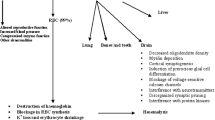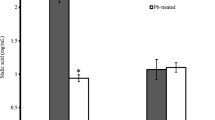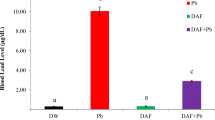Abstract
The experiment was performed on female rabbits that receivedper os equimolar doses (17 μM Me/kg) of SnCl2×2H2O or Pb (CH3 COO)2 every day for 5 d. The activity of δ-aminolevulinic acid dehydratase (ALA-D) in the whole blood, liver, kidneys, brain, spleen, and bone marrow, concentration of free erythrocyte protoporphyrins (FEP), activity of δ-aminolevulinic acid synthetase (ALA-S) in the liver and bone marrow, urine δ-aminolevulinic acid (ALA-U), and coproporphyrins (CP-U) were determined. Lead and tin concentrations in the blood were estimated.
Lead caused a significant inhibition of ALA-D in the blood, increased FEP concentration, and ALA and CP excretion in urine of rabbits. Lead also decreased ALA-D activity in the bone marrow and in the liver, and did not change ALA-2 activity in the liver and bone marrow.
Tin did not change any of the examined indices. Tin doses applied in the present study, maintained within the limits of permissible standards of metal levels in human diet, did not affect the process of heme biosynthesis in rabbits.
Similar content being viewed by others
References
A. P. De Groot, V. J. Feron, and H. P. Til,Food Cosmet. Toxicol. 11, 19–30 (1973).
M. Chiba, K. Ogihara, and M. Kikuchi,Arch. Toxicol. 45, 189–195 (1980).
G. Zareba and J. Chmielnicka,Ecotoxicol. Environ. Saf. 9, 40–46, (1985).
G. Zareba, J. Chmielnicka, and G. Kustra,Ecotoxicol. Environ. Saf 11, 144–152 (1986).
K. Tomokuni and M. Ichiba,Ind. Health 27, 131–134 (1989).
G. Zareba and J. Chmielnicka,Biol. Trace Elem. Res. 20, 233–242 (1989).
WHO/UNEP Environmental Health Criteria—Tin and Organotin Compounds. WHO, Geneva, 1980.
FAO/WHO Evaluation of Some Pesticide Residues in Food. Food and Agriculture Organisation of United Nations, World Health Organisation, Rome, 1971.
K. Tomokuni,Arch. Environ. Health 29, 274–281 (1974).
E. Schlick, K. Mengel, and K. D. Friedberg,Arch. Toxicol. 53, 193–205 (1983).
S. Piomelli,Clin. Chem. 23, 264–269 (1977).
B. Haeger-Aronsen,Scan. J. Clin. Lab. Investig. 12, Suppl.47, 1–37 (1960).
O. Wada, Y. Yano, S. Kurashina, T. Ono, Y. Aoki, and K. Toyokawa,Asian Med. J. 13, 581–590 (1979).
S. Sassa, A. Kappas, S. E. Bernstein, and A. P. Alvares,J. Biol. Chem. 254, 729–735 (1979).
A. A. E. Wibowo and R. L. Zielhuis,Arch. Toxicol. 45, 67–73 (1980).
D. F. Gerken and M. S. Swartout,Am. J. Vet. Res. 47, 2674–2681 (1986).
R. A. Hiles,Toxicol. Appl. Pharmacol. 27, 366–379 (1974).
J. E. Furchner and G. A. Drake,Health Phys. 31, 219–224 (1976).
K. Horiuchi,Osaka City Med. J. 16, 1–9 (1970).
H. W. Schlipkoter and F. Poot,Environmental Health Aspect of Lead, Center for Information and Documentation, Luxemburg, 1973.
P. Fritsch, G. De Saint Blanquat, and R. Derache,Food Cosmet. Toxicol. 15, 147–149 (1977).
B. Aungst and H. L. Fung,J. Toxicol. Environ. Health 16, 147–152 (1985).
WHO/UNEP Environmental Health Criteria—Lead. WHO, Geneva, 1977.
J. Bankowska and C. Hine,Arch. Environ. Contam. Toxicol. 14, 621–629 (1985).
J. P. Buchet, H. Roels, G. Hubermont, and R. Lauwerys,Toxicol. 6, 21–34. (1976).
D. C. Wigfield, C. L. Chakrabarti, S. C. Wright, J. A. Eastwood, R. Karkowska, and P. M. Johnson,J. Appl. Toxicol. 6, 371–379 (1986).
R. M. El-Gazzar, V. N. Finelli, J. Boiano, and H. G. PeteringToxicol. Lett. 1, 227–234 (1978).
M. J. Henderson and C. Toothill,Clin. Science 65, 527 (1983).
J. D. Maxvell and U. A. Meyer, inPorphyrins in Human Diseases, M. Doss, ed., 1976, pp. 1–9.
A. Goldberg, P. A. Meredith, S. Miller, M. R. Moore, and G. G. Thompson,Br. J. Pharmacol. 62, 529–536 (1978).
A. Kappas and M. D. Maines,Science 192, 60–62 (1976).
G. S. Drummond and A. Kappas,J. Clin. Invest. 77, 971–976 (1986).
M. Kajimoto, M. Kondo, M. Niwa, T. Suzuki, H. Kimura, A. Sasaki, and G. Urata,Arch. Toxicol. 52, 1–11 (1983).
F. Labreche and A. P’an,Int. Arch. Occup. Environ. Health 51, 35–44 (1982).
Author information
Authors and Affiliations
Rights and permissions
About this article
Cite this article
Zareba, G., Chmielnicka, J. Disturbances in heme biosynthesis in rabbits after administrationper os of low doses of tin or lead. Biol Trace Elem Res 34, 115–122 (1992). https://doi.org/10.1007/BF02785241
Received:
Accepted:
Issue Date:
DOI: https://doi.org/10.1007/BF02785241




